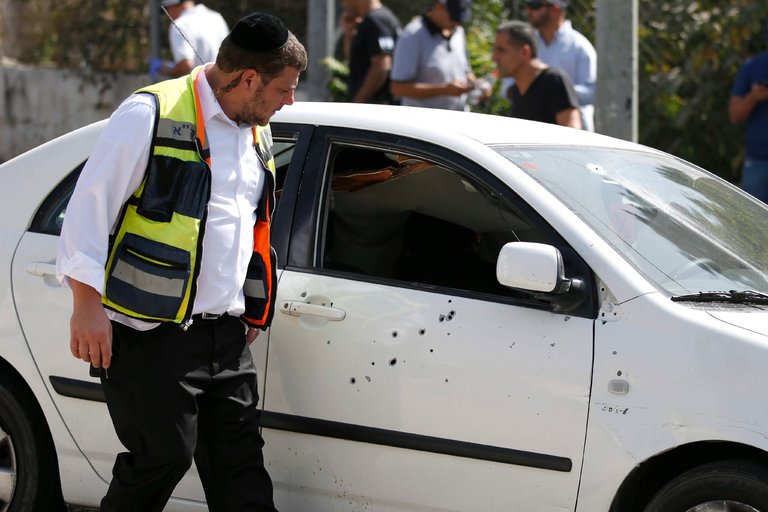
JERUSALEM — A Palestinian gunman made a brazen choice of location for a deadly rampage on Sunday: Driving a speeding car, he fired at civilians near a light rail stop opposite Israel’s national police headquarters, on the main road that runs between West Jerusalem and the predominantly Palestinian eastern part of the city.
He then fled in the vehicle to a nearby Palestinian neighborhood, where he exchanged fire with police officers from a special counterterrorism unit who had chased him on motorbikes, according to the police.
Soon afterward, a border police unit arrived and shot the gunman dead. The police identified him as a 39-year-old resident of East Jerusalem.
Two Israelis were killed. The police said one was a member of its counterterrorism unit, Yosef Kirma, 29. The second was identified as Levana Malihi, 60.
The assailant, whose name was not released because of a court order, was supposed to report to an Israeli jail on Sunday morning to serve a four-month term for assaulting a police officer in 2013, according to Israeli and Palestinian news reports. He had been jailed in the past for security offenses and incitement to violence, the reports said.
A day before the shooting, he told Maan, an independent Palestinian news agency, that he intended to report to prison in Ramla, a city in central Israel, at 10 a.m. on Sunday. Instead, he apparently headed to the area around the police headquarters in Jerusalem.
The Magen David Adom Israeli ambulance service got the first call about the shootings at 10:12 a.m. In addition to the two deaths, it said, three people were wounded by gunshots and two women were slightly injured when the assailant’s car hit their vehicle as he tried to flee.
Hamas, the Islamic militant group that controls the Palestinian coastal territory of Gaza, praised the attack and described the gunman as “one of ours.”
Al Quds, the Hamas-affiliated television station, broadcast a video that it said was exclusive to the channel and that it described as the perpetrator’s last words. It was not clear when or where the video had been filmed.
In it, the man, wearing a green polo shirt, the color of Islam and of Hamas’s flag, stood before a map of historic Palestine.
He said he was sending “a message to the people of Jerusalem and the youth of Jerusalem to keep resisting for Al Aqsa holy mosque,” the contested Jerusalem holy site also known to Muslims as the Noble Sanctuary and to Jews as the Temple Mount, and a focus of tensions and unrest in recent years.
The State Department and the United Nations special coordinator for the Middle East peace process, Nickolay Mladenov, condemned the attack.
The area where it occurred has been the site of numerous stabbing, car ramming and shooting assaults over the past year. At first, a witness said, the gunfire blended in with the hacking sound of roadwork, but passers-by soon started running in panic. The police released a photograph of the gunman’s car, a white sedan pockmarked with bullet holes.
Prime Minister Benjamin Netanyahu praised what he described as the “swift and determined action” of the police.
The Israeli police chief, Roni Alsheich, said that because of the heavy police deployment in the area, the entire event was over in three or four minutes.
Later, the police said they had detained Palestinians who were distributing candy in Jerusalem to celebrate the shooting as well as activists who were demanding that stores close in a sign of solidarity with the killer.
Israeli security officials had forecast a new wave of violence around the period of the Jewish High Holy Days and coinciding with the first anniversary of the outbreak of Palestinian stabbings, shootings and car attacks. Most of these crimes have been committed by so-called lone wolves — Palestinians acting without the assistance of known Palestinian organizations and, in many cases, without any particular political affiliation.
The attacks had waned in recent months but surged, as if on cue, after the Muslim feast of Eid al-Adha and in the prelude to the Jewish holidays, which began a week ago. In the last two weeks of September, the Israeli authorities reported about six stabbings or attempted stabbings and one car ramming, mostly in the West Bank.
Those assaults wounded eight Israeli soldiers and border police officers. Five assailants were killed, among them a Jordanian visitor who was caught on security cameras lunging toward Israeli police officers with a knife at the Damascus Gate, one of the busiest entrances to the Old City in East Jerusalem.
Israeli officials have said that this time, the attackers found the Israeli security forces better prepared to respond.
Gilad Erdan, the public security minister, urged Israeli Jews on Sunday to continue to come to Jerusalem to perform the rituals that are traditional at this time in the Hebrew calendar.
A large gathering was expected at the Western Wall, a Jewish holy site in the Old City, on Monday night, with the chief rabbis of Israel scheduled to be in attendance. Mr. Erdan called on people to come and “show the accursed terrorists that they will not beat us.”
Since Oct. 1, 2015, about 40 Israelis and others, including two American visitors, have been killed as a result of the attacks. More than 230 Palestinians have been killed during the same period, according to the Palestinian Ministry of Health — the majority of them while carrying out or trying to carry out attacks, by Israel’s count.
Continue reading the main story

